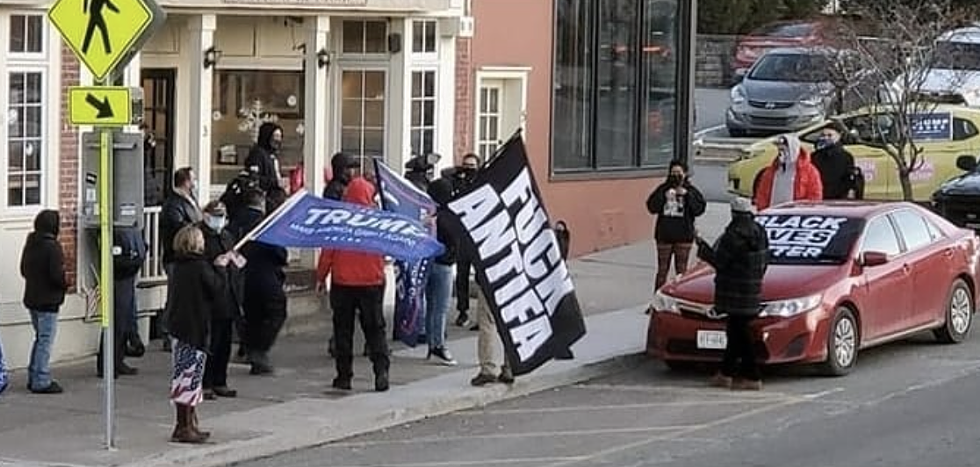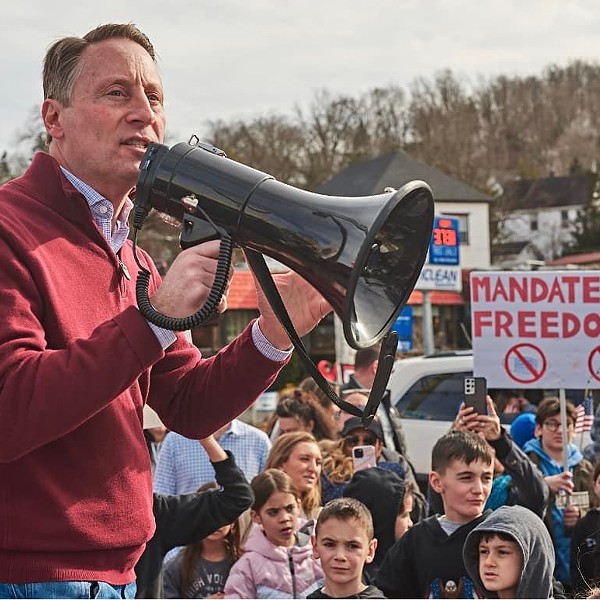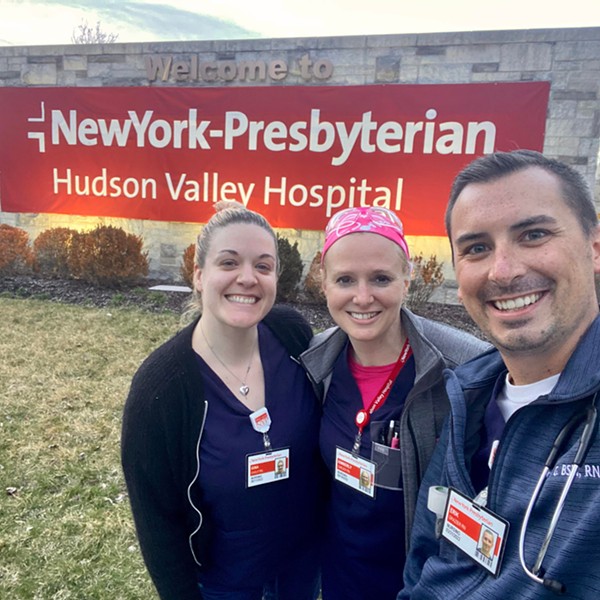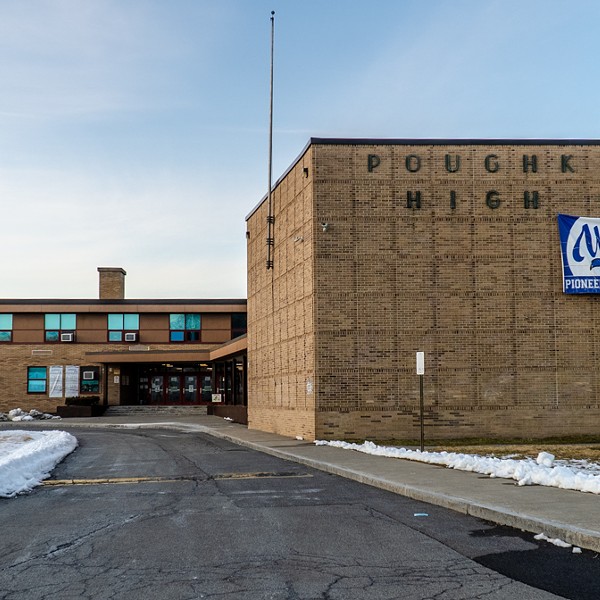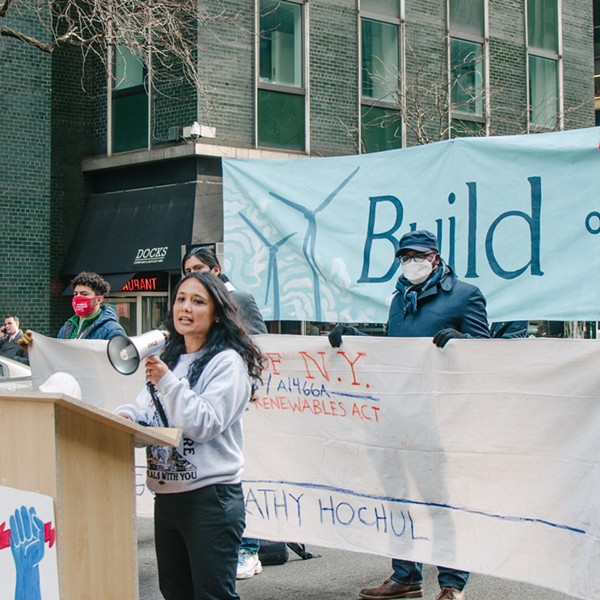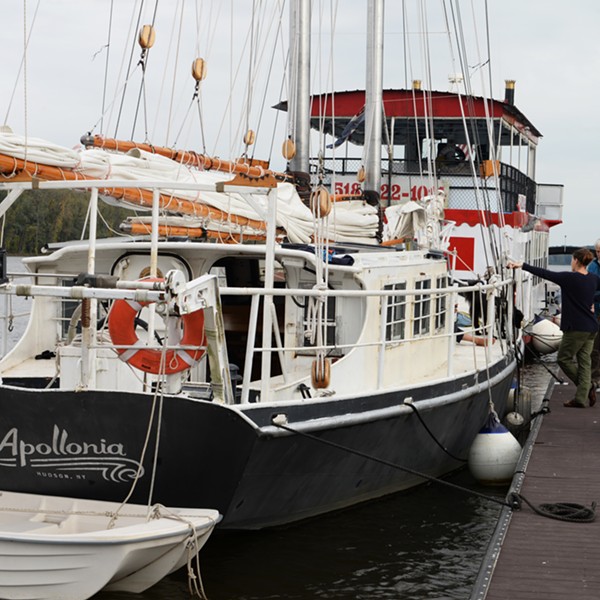The town of Warwick looks like a Norman Rockwell painting. Between the sprawling onion fields and apple orchards, you will find tall white steeples, country living boutiques, Revolutionary War-era taverns, and one of the best small libraries in the United States. Residents are civically engaged, and communicate through the opinion sections of the town’s two weekly newspapers, the Warwick Advertiser and the Warwick Valley Dispatch. But this image of bucolic neighborliness was disrupted in early January, when Tom Torres, one of the owners of the popular Caffe a la Mode—known for its graham cracker coffee and frothy chais—attended the riots at the US Capitol.
It wasn’t hard for a few millennials with an internet connection to find and expose the Twitter and Parler accounts of Torres and cafe co-owner Scott Elfant, which included such statements as how Hitler was “actually a very good person,” and suggestions that Michelle Obama and Michigan Governor Gretchen Whitmer should be executed. Torres’s longer live videos promoted the baseless QAnon conspiracy theory, which claims an elite cabal of satanic Jews have orchestrated an elaborate deep-state child trafficking ring, with the intention of harvesting their blood.
While some Warwick residents called for a boycott of the cafe—a favored haunt of teens and families, and once home to a lively pre-pandemic open mic—others attended a “freedom rally” in support of the owners the following Sunday. A slew of letters to the editor appeared in both papers; many expressed shock, disavowing the hateful statements and attempted insurrection at the Capitol, while some suggested that Trump was being unfairly censored by Orwellian social media companies and accused the editors of engaging in far-left conspiracies to discredit conservative readers.
Rabbi Rebecca Pomerantz Shinder of Temple Beth Shalom wrote a letter that was cosigned by other local faith leaders: “My real hope was to let children know that this is what their religious leaders believe. Because the die is already cast—so to speak—for their parents.”
The controversy surrounding the cafe has presented a new question for Warwickians to consider: How did a trendy, rustic coffee shop became a symbol of the growing presence of white supremacist conspiracy theories, and the divide between those who have been inculcated by them and those who have not?
An Unexamined Past
In many ways, Warwick’s town culture is ripe for this reckoning. Like other small towns throughout the Hudson Valley, Warwick’s residents have resisted meaningful discussions about the connections between race, history, and our present moment. But it wasn’t that long ago—2016—that residents were painting over swastikas at the Temple Beth Shalom cemetery. Last month, recruitment propaganda for a white nationalist group was found on the corner of Main Street. And, about a hundred years ago, the town was home to an active chapter of the Ku Klux Klan.
In the summer of 2020, the discord came to a head when local activists organized rallies and marches in the wake of George Floyd’s death, and young people of color spoke out about their experiences of racism at school and in interactions with police. Some residents affirmed the necessity of the protests and shared their own experiences of racism, while others responded with outrage against the Black Lives Matter movement, disbelief that racism even exists in Warwick, and nostalgia for simpler days.
Dennis Van Dunk, a 2017 graduate of Warwick Valley High School, recalls how one day during his lunch period, some white classmates reacted to the school’s new Black principal by jokingly shouting “white power.” As far as he knows, they never faced consequences.
Another time, Van Dunk’s neighbor initiated a shouting match with some kids from Kings Estates who were riding their bikes in Wickham Village. For years, Kings Estates, as the first majority nonwhite neighborhood in Warwick, has had an exaggerated reputation among white Warwickians for crime and gang activity. Van Dunk says the neighbor made an made an off-handed remark to his father, who is Black, about how he was “going to burn a cross and make sure they never come back.”
Such casual adoption of white supremacist language as an edgy joke resonates with many of the personal stories of racism and unbelonging published in the Advertiser last year. There is a popular myth that racism is mainly the scourge of the South, where slavery, Jim Crow, and other overt forms of institutional oppression prevailed far more recently than they did in the North. In reality, systemic racism persists acutely in northern towns like Warwick, but is seldom acknowledged.
In the early 1920s, the Ku Klux Klan was rebranding itself as a fraternal organization that emphasized nationalism, popularizing variants of the slogan “America first.” Reflecting trends throughout Orange County, Warwick was home to several meetings of a local chapter throughout the early 1920s. The Advertiser and the Dispatch reported on numerous Klan events, including a gathering of over a thousand members, an initiation ceremony featuring 30-foot-tall burning cross, and a town-sanctioned parade of over 500 robed participants marching down Main Street. On the day of that parade, the Warwick village board even provided additional police officers to assist with the increased traffic.
Historian Linda Gordon recently shared in a Vox interview that white supremacist movements throughout American history have “often included supposed pillars of the community—professionals, businesspeople, and especially law enforcement officials.” In 1920s Warwick, the KKK counted among its members political leaders such as Justice of the Peace William Sproul and Edgar Houston, who ran for town supervisor while recruiting others for the Klan and would later go on to serve on the town planning board.




Prior to the chapter’s most prolific period of activity, there are at least two accounts in the Dispatch of people dressing up as klansmen as practical jokes or as live entertainment. This took place at public gatherings, such as a meeting of the intellectual salon the Fortnightly Club, or a Rod and Gun Club celebration. To Black and Jewish people, Catholics, and immigrants, it was a terrorist organization, but to many white folks, the Klan made for a good laugh.
After the 1920s, the KKK’s momentum stalled, its membership plummeted, and it became a less socially acceptable extracurricular activity. The advent of the civil rights movement and institutions such as the Equal Employment Opportunity Commission made a dent in Warwick’s social landscape. “If you look at the 1990s, it would take your breath away,” says Warwick Town Historian Dr. Richard Hull, describing the way that Warwick’s Black residents rose to unprecedented levels of leadership in government, education, and industry in the second half of the 20th century. Among them were elementary school teacher Beverly Braxton, who helped to found Warwick’s Partners in Education program; Sugar Loaf resident Hugh Marius, who was the first Black president of the Orange County Chamber of Commerce; and community titan Dorothy Anderson. “It was like a revolution,” says Dr. Hull.
The repercussions of the civil rights movement in Warwick were complex and bittersweet. After the 1968 assassination of the Reverend Dr. Martin Luther King, the Warwick town board moved to form a human relations commission to combat racism on a local level, and the appointment of commission members quickly became an issue of local politics. The editorial board of the Advertiser took its own stand, writing that “while we can’t say that all is 100 percent perfect in Warwick, we feel that there are not enough abuses of human rights to necessitate the formation of a commission to deal with these minor complaints.” When Black residents wrote letters to the editor in disagreement and the Dispatch published its own dissenting editorial, the Advertiser doubled down: “While discrimination may still be practiced in many parts of the country, in Warwick we feel that discrimination is the ‘exception and not the rule.’”
Warwick was not unique in struggling to even acknowledge racism; indeed, the debate over the commission echoed national trends. “The Civil Rights Act of 1964 was not the beginning of the end of American racism,” historian Ibram X. Kendi wrote in a 2017 piece for The Washington Post. “It was the beginning of our poisonous belief that America was ending racism.”
Ralph von Chancellor, a teacher and administrator at the New York State Training School for Boys in Warwick, wasn’t having any of it. In a followup letter to the Advertiser, he wrote:
I want the same opportunity that any Caucasian has—to buy my home where I want—to walk the streets with dignity—and be able to say I am a man. Bow your head in shame Mr. Editor—because these things are not happening in Warwick. Discrimination IS the rule in Warwick.
A Beautiful Exterior
If Warwick is like a Norman Rockwell painting, it may more closely resemble New Kids in the Neighborhood or The Problem We All Live With than it does Freedom From Want. A year after the human relations commission kerfuffle, a letter to the editor of the Advertiser from residents Mary and Irving Pierce detailed daily interactions ranging from chillingly inhospitable to overtly racist in their white, middle class neighborhood on John Street (the letter ended with a declaration of their determination to move). A 1972 report about substance abuse among youth in the Advertiser Photo News included an interview with a Black boy named Joey, who shared he had been recently thrown out of a bar for flirting with a white girl. That same year, recruitment flyers for the National Socialist White People’s Party were found at the Warwick Post Office. On the first night of Passover in 1986, two homes in Greenwood Lake were vandalized with a partially burned cross and graffitied slurs. Police blotters indicate the occasional swastika or other racial slur defacing private or public property over the years.
While the racism of today may often appear subtler or more systemic (consider Warwick's median value of owner-occupied housing units at $325,000, more than twice that of the city of Newburgh), the illusion of a colorblind community unaffected by race has persisted. Residents’ lasting distaste for the conversation was put front and center in Samantha Knowles’ 2018 documentary The Blue Line, which tracked the debates that followed the town painting a blue line in support of law enforcement down the middle of Railroad Avenue in 2016.
“[Warwick] has this very beautiful exterior—it’s very easy to feel inclusive and separate from the world,” says Knowles, who grew up in town.
In the documentary, a town hall devolves into a heated shouting match as pro-line advocates refer to Black people as “animals” and parrot false claims about Black Lives Matter. In the months leading up to the 2016 election, Knowles remembers the rising white supremacist rhetoric that characterized Donald Trump’s campaign, and how the fatal police shootings of Philando Castile and Alton Sterling rocked the country. The decision to paint the blue line at that particular political moment sent a signal to her: “I knew that other people didn’t realize how political and how fraught with race it was.”
Bearing witness to the ensuing debates was both difficult and eye-opening for Knowles. “Even though I had all those moments as a kid where I was othered, I didn’t realize there was that kind of contingent in Warwick,” she says. While Knowles was aware of her hometown’s conservative politics, coming face-to-face with the toxic combination of racism and misinformation was a shock to her perspective of the place. “It always felt like hatred towards Black Lives Matter was something that was prevalent in the country, but so far away from me.”
In recent years, the Warwick Historical Society and the Albert Wisner Public Library have worked to highlight the rich and complex history of Warwick’s Black, indigenous, and people of color populations. Deputy Town Historian Sue Gardner has compiled an online guide of historical sources on topics ranging from documentation of enslaved people, to the formation of the Union African Methodist Episcopal Church, to accounts of the Black resort community at Greenwood Forest Farms. “When the Black Lives Matter protests surged in early 2020, I kept hearing people relate their experiences of racism and be told that what they were saying wasn’t true because others had not experienced or witnessed that,” says Gardner. “I kept referring people back to these documents.”
While the KKK no longer has the same organized presence in Warwick today, that may be by design. According to Gordon, the historian, “today, the Ku Klux Klan is just one small group among many, many different white supremacist groups,” and while this decentralized model may appear to be disorganized, the internet and social media allow them to collaborate so that “it really isn’t necessary for them to have one single large organization.”
The controversy surrounding the owners of Caffe a la Mode hasn’t happened suddenly or in a vacuum. One doesn’t need to look hard to find evidence of white supremacist ideologies in Warwick: dog whistles about George Soros, defenses of the confederate flag, active membership in the Proud Boys, a far-right hate group.
Nice, Normal People
Since the debates over the blue line, Knowles has been coming to terms with the idea that seemingly nice, normal people in her community could buy into conspiracy theories. She says of her perspective a couple years ago, “I could not believe that people in my hometown—that woman you always see at ShopRite, your yoga teacher—that they could believe this misinformation.” Now, these beliefs feel far less fringe to her.
It would be a mistake to characterize Warwick as a hotbed of white supremacy, or as being uniquely susceptible to the far right. Rather, it has served as a microcosm for our country’s most sensitive pressure points. In that, it resembles many other Hudson Valley towns that have struggled to come to terms with race.
The Green Book Hudson Valley is an anonymously run Facebook page whose description reads: “Local racist history is often the last thing our local communities want to talk about and the reason we still live in societies that support white supremacy.” Since the January 6 riots, the page has mainly been posting about local political and business leaders who participated in the attempted insurrection or tacitly supported it—such as New York State Assemblyman Colin Schmitt, who spoke to a bus full of protestors before they left for Washington, DC, or the Parler accounts of District Attorney David Hoovler and Orange County Legislative Chairman Thomas Faggione. The page has also sought to expose members of the Orange County Sheriff’s Department and other local police departments who are connected to the Oath Keepers, a far-right militia comprising current and former military and law enforcement.
The urgency of addressing racism on a local level is clear to Dr. Hull, the town historian. “If prominent people begin to make remarks that are antisemitic and white supremacist and so forth, many other people who share those sentiments become outspoken too,” he says. “It can have a cascading effect which can be very dangerous.”
Rabbi Shinder recalls the outpouring of support from the community, including other faith leaders, after the vandalism of the cemetery. She and other community leaders had to reconsider their assumptions when it turned out that the young man who carried out the desecration was a successful student in the nearby Florida school district. “He was well regarded. And it absolutely stunned and floored the principal of the school and the superintendent of the school,” which already had educational programs about intolerance and inclusion. “So something had to be brewing within his home, within his circle of friends, somewhere he had this notion that he needed to do this.”
Warwick is full of nice, normal people—and that may be a part of the problem. The idea that nice, normal people are involved in QAnon and its sister groups is a tough pill to swallow, and niceness does not lend itself well to difficult, honest conversations about historical oppression. The town contains multitudes; acknowledging decades’ worth of pain and ugliness could disrupt Warwick’s impression of pastoral beauty and prosperity, but perhaps it will be possible to hold two truths at the same time.
For Rabbi Shinder, the dark nadir of the internet that has spread such virulent antisemitism over the past year feels like a new development since the cemetery was attacked in 2016. “I don’t think it was as prevalent then,” she says. “Or, maybe it was, and no one was paying attention.”







